Marine
Life Society of South Australia Inc.
Newsletter
June
2005 No.
322
“understanding, enjoying & caring for our
oceans”
Next Meeting
This
will be our General Meeting and will be held at the Conservation Centre, 120
Wakefield Street, Adelaide on Wednesday 15th June
commencing at 7.30pm.
Our guest speaker
will be Will Zacharin who
will be speaking on the topic of the Sustainable Management of
Fisheries.
Contents
2005 Annual
General Meeting
Numerous
Nudibranch Findings
Diving
the Apple Isle
Anniversary
Trophy Re-vamp
ARTICLES
Newsletter
and Journal articles are still needed. Please send any contributions in by
Email, letter or give to me at a Meeting.
2006
Calendar
This
is now available. AUS$8 to members and AUS$10 to non
members. Please buy as many as possible and also sell to anyone who
is interested.
We almost sold every
2005 calendar! A wonderful
effort.
People
who have seen the new edition say it is our best yet.
This
Newsletter
The hardcopy of the Newsletter is in black and white as usual. If members prefer a colour PDF version then please email me.
2005 Annual General Meeting
The 2005
Annual General Meeting resulted in the following Committee positions (*with the
exception of that of the Secretary) being filled by the previous Committee,
viz:
President Philip Hall
Secretary Vacant
Treasurer Phill McPeake
Ctee 1 Chris
Hall
Ctee 2 David
Muirhead
Other
non-executive positions were filled as follows:
Editor:
Philip Hall
SDF Reps.:
Neville Skinner
Steve Reynolds
Con Council Rep.:
Vacant
Reefwatch Rep.:
Kevin Smith
Social Officer:
Steve Reynolds
Photo Index Officer:
Steve
Reynolds
Librarian:
Steve Reynolds
Website Manager: Danny
Gibbins
Auditor:
Phill John
*Steve indicated he
would not be standing for Secretary a day before the AGM so we now need a new
Secretary. We have received a nomination from David Muirhead for Neville Skinner
which was accepted. This will be voted on at the June Meeting. We thank Steve
for his work over the years.
It is worth noting
that the Executive Committee had not changed for several years. We must have
done something right!
New blood in the
Executive is usually a good thing so please consider standing next year either
for Committee or for one of the non-executive positions.
Numerous Nudibranch
Findings
by Steve Reynolds
Polycera
hedgpethi
At the beginning of June 2004, former
MLSSA member Dennis Hutson found lots of a particular nudibranch at the North
Haven boat ramp. He took one of them home for his aquarium. He emailed a
photograph of the nudibranch in his holding bucket to me because he wanted me to
identify it and tell him what it eats before he would put it into the
aquarium.
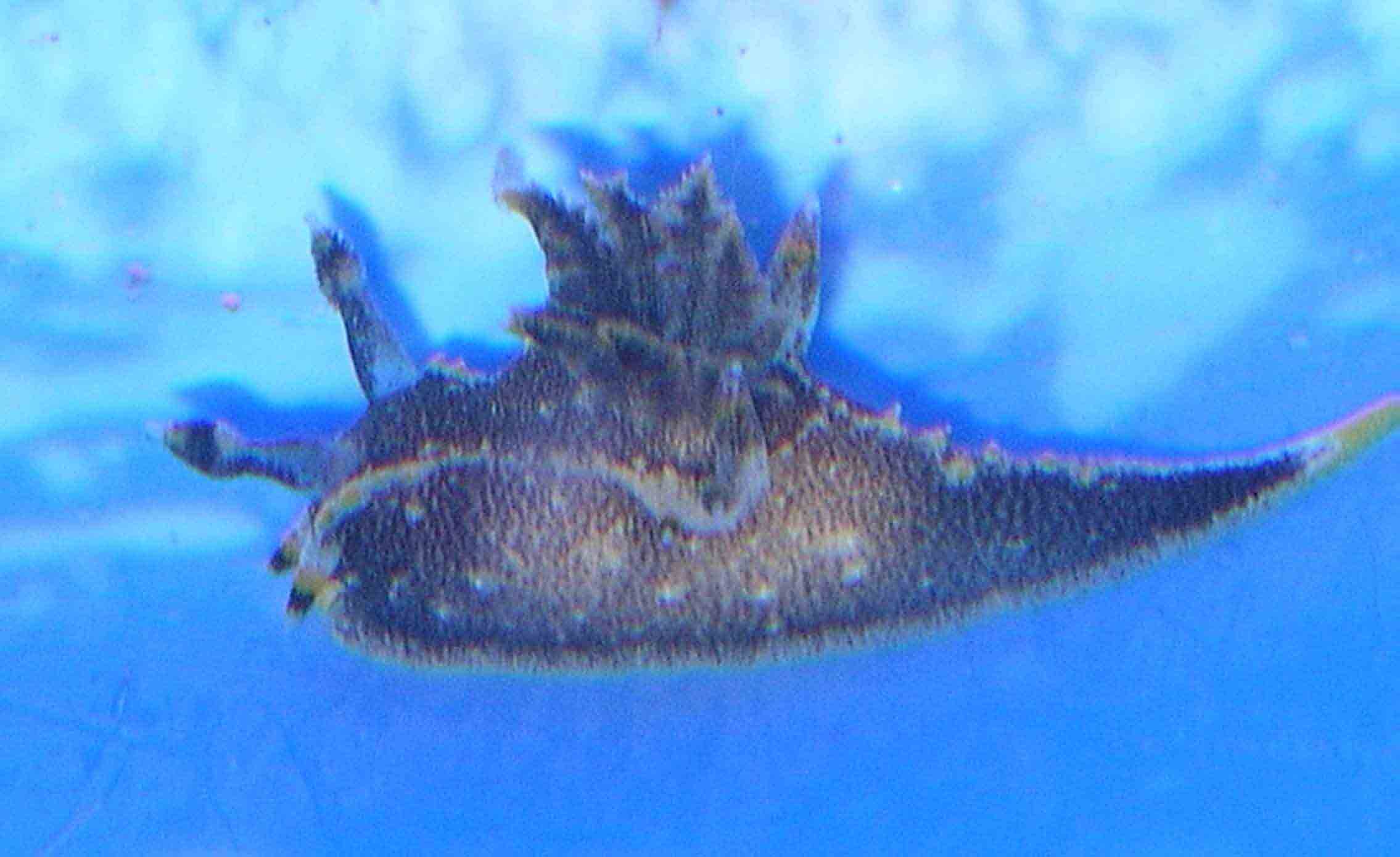
Polycera hedgpethi
My nudibranch reference book did not
include details of the specimen at all. I quickly forwarded Dennis’s email on to
Thierry Laperousaz, Senior Collection Manager for
Marine Invertebrates at the SA Museum’s Science Centre, to see if he could help.
Thierry was quick to reply, saying that the nudibranch is Polycera hedgpethi,
Marcus (1964). Nerida Wilson, the biologist
specialist in nudibranchs at the museum had identified the nudibranch for
Thierry. She also supplied him with the following interesting details which he
passed on to us.
Thierry said that this nudibranch was very
interesting for many reasons. He said that, in Australia, it has been recorded
only from Western Australia, New South Wales and Victoria. It is believed to be
an introduced species coming from California in the US where it was first
described. Thierry also said that this sea slug is a predator, feeding
exclusively on Bugula species of bryozoan. It was thought that the nudibranch most probably
fed on Bugula nerita which is also an introduced species. If that was
to be the case, to be able to keep it in aquaria means that you have to get the
bryozoan as well. Thierry also said that he was very
interested to actually collect a few specimens for the SA Museum mollusc collection as it would be one of the first
records of this species in SA. He guessed that the location would be
somewhere in the Port River system where many feral species have been introduced
in our waters (from ships ballast water). He wanted to know the exact location
so the museum could access the locality. When I told Thierry about the North
Haven location, he said that he would make arrangements to collect his own
specimens there. (That was his intention but he never made it
there.)
Thierry also gave me the following
internet link where I could find more about this creature - http://www.seaslugforum.net/polyhedg.htm
. There were apparently 11 pages to this web page. I just printed out page 1
which gave the following taxonomic details: - Order Nudibranchia, Suborder Doridina,
Family Polyceridae, Subfamily
Polycerinae. This page featured two photos of Polycera hedgpethi
and details about its distribution. Its natural distribution is apparently
unknown. As already mentioned above, it was first described from California. It
is also known from port regions in West and South Africa, Australia and New
Zealand, the Mediterranean, Spain and Japan. The Victorian record was from Mallacoota, which is in the north of the State, in 1973. The
New South Wales record was from Sydney in the same year. The single report from
Western Australia was in the early 1980s (Albany).
The page also described Polycera hedgpethi
as an interesting member of the fouling community associated with Bugula and said that its present distribution is
probably the result of shipping rather than natural
causes.
The page described the species as “A
typical Polycera”, saying that “it has a
frontal veil bearing 4-6 pointed processes which are white-tipped with an upper
band of gray-black (sic) and a lower one of yellow. Its body is covered with
black or grey speckling. The ridges between rhinophores and gills, and gill to tail are clear of specks
and appear white to yellow. The rhinophore club has a
black lower, and a yellow upper band, and the gills are grey or blackish with
yellow tips. The extra-branchial appendages are
similar in colour to the anterior frontal veil processes”.
Dennis later told me that he had disposed
of his nudibranch humanely. He had felt that it would be wrong to return it to
the ocean since it wasn't a native species. He also said that when he was
collecting more salt water for his aquarium he found several more. He said at
the time that they appeared to be grazing on ascidians and weed but later
decided that this assumption was incorrect. Dennis returned to the North Haven
boat ramp on Wednesday 30th June for his weekly collection of fresh
seawater for his aquariums. He found, as usual, more specimens of Polycera hedgpethi
there. He collected two live specimens which he took in to Thierry Laperousaz and Nerida Wilson at
the SA Museum the next day. The very next day again, Thierry informed me by
email that they had been able to take some photographs of the animal. They
were also able to collect some of its eggs since they were apparently spawning.
Nerida Wilson was quite interested in the
specimen. She fixed these two specimens for future molecular analyses. The
very next day again, Dennis met me at our local dive shop. He was pleased to
report that his name was going down on record as being one of the first people
to find the species in SA. He also thanked me for my help and assistance in the
matter.
(The registration number for Dennis’s
nudibranchs in the South Australian Museum collection is SAM
D12299.)
On 7th July Nerida left a message referring me to http://crimp.marine.csiro.au/nimpis/.
(CRIMP is the acronym for Centre for Research on Introduced Marine Pests. NIMPIS
is the acronym for National Introduced Marine Pest Information System.) At this
web site I found several pages of information about Polycera hedgpethi (or Hedgpeth’s Dorid) and printed out
many of them. The first page gave the following taxonomic details: - Phylum
Mollusca, Class Gastropoda,
Subclass Opisthobranchia, Order Nudibranchia, Suborder Doridoidea*, Superfamily Anadoridoidea, Family Polyceridae,
Genus Polycera.
* The Sea Slug Forum web page gave the
Suborder as “Doridina”.
The CRIMP web page featured a photo of
Polycera hedgpethi credited to both Richard Willan and Neville Coleman (1984). It would be taken from
their book “Nudibranchs of Australasia” (which I no longer
have).
Dr Richard Willan was once a MLSSA member. He was working as the
Curator of Molluscs at the Northern Territory Museum of Arts & Sciences in
Darwin the last time that I was in contact with him.
The first page of the “Species Summary”
described Polycera hedgpethi as “a small elongate sea slug up to 50mm in
length, widest just before the gills. The body is peppered dark grey or black,
the foot translucent white and the tip of the tail yellow-orange. There are 2-4
pointed white tentacles with yellow-orange or white tips on each side of the
head and these continue as tubercles along the sides of and scattered over the
body. The oral tentacles are short and simple, the
(perfoliate) rhinophores are
grey with white and yellow spots. The 9-10 external (tripinnate) gills are grey with yellow tips and are
surrounded at the rear by 3 large finger-like appendages on each side which are
white with grey flecks and a band of orange-yellow”. This was followed by a
diagram showing the key features.
Some key references are listed on page 3
of the “Species Summary”. Polycera hedgpethi
was apparently first described by E.Marcus in “A new
species of Polycera (Nudibranchia) from California”, Nautilus
77:128-131.
According to the “Identification Details”
page, Polycera hedgpethi reach 50mm in length in California, 40mm in
South Africa and 10-15mm in Australia.
According to the “Reproduction and Growth”
page, Polycera hedgpethi are “Often found during the winter months
(May-Aug) in Sydney Harbour”. This ties in with
Dennis’s discovery of them.
According to the “Habitat” page, Polycera hedgpethi
occurs subtidal to a maximum depth of
10m.
I checked the SDF’s copy of CRIMP’s “A Guide to
the Introduced Marine Species in Australian Waters” by Dianne M Furlani. I found that there is a page of details about Polycera hedgpethi
under “Mollusca” (updated May 1996). This featured
Willan & Coleman’s photo of the nudibranch. It
seems that juvenile Polycera hedgpethi “possess blue bands on velar and extrabranchial processes”. Juveniles, because of their
different appearance have been called by the synonym Polycera gnupa.
I asked Thierry whether or not any of the
relevant authorities had been informed about the discovery of Polycera hedgpethi
in SA waters. He told me that Tim Kildea from SA Water
has been informed and that he was in touch with SARDI
(Fisheries).
On 26th July Nerida Wilson told me that while Polycera hedgpethi
is an introduced species, it is not considered to be a pest species, and should
be left undisturbed.
Early in August Dennis Hutson did a dive
on the New Endeavour, the sailing ship that sank in the Port River
recently. Dennis said that he found lots of the nudibranch during this
dive.
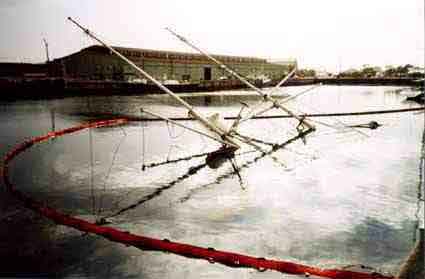
The New Endeavour at its resting place in the Port River
(Dennis said “The New Endeavour is
a great dive. Geoff Prince and I did a penetration to the engine room. As it is
an "unsafe" wreck, we used dive reels and observed proper safety techniques. It
isn't a dive I would recommend to just anyone for that reason and the high entry
required, the polluted water.....I took some photos and Geoff intends on writing
a blurb for MLSSA. We plan on diving it some more to survey the whole vessel.
We'll keep you informed.”)
By the time that Dennis and Geoff dived on
the New Endeavour again in October, there was no evidence of Polycera hedgpethi
any more. Nerida is now writing a paper about the
occurrence of Polycera hedgpethi in SA waters, and has arranged to submit the
paper in a special opisthobranch edition of the
Records of the Western Australian Museum.
I have kept a file about this matter and
it has been placed into our library – “Nudibranch Polycera hedgpethi”
(MLSSA No.2210).
Elysia
?expansa
In August 2004 Dennis said that he had
found another species of nudibranch whilst diving. He believed it to be Elysia expansa, a
West Australian species of Elysia.
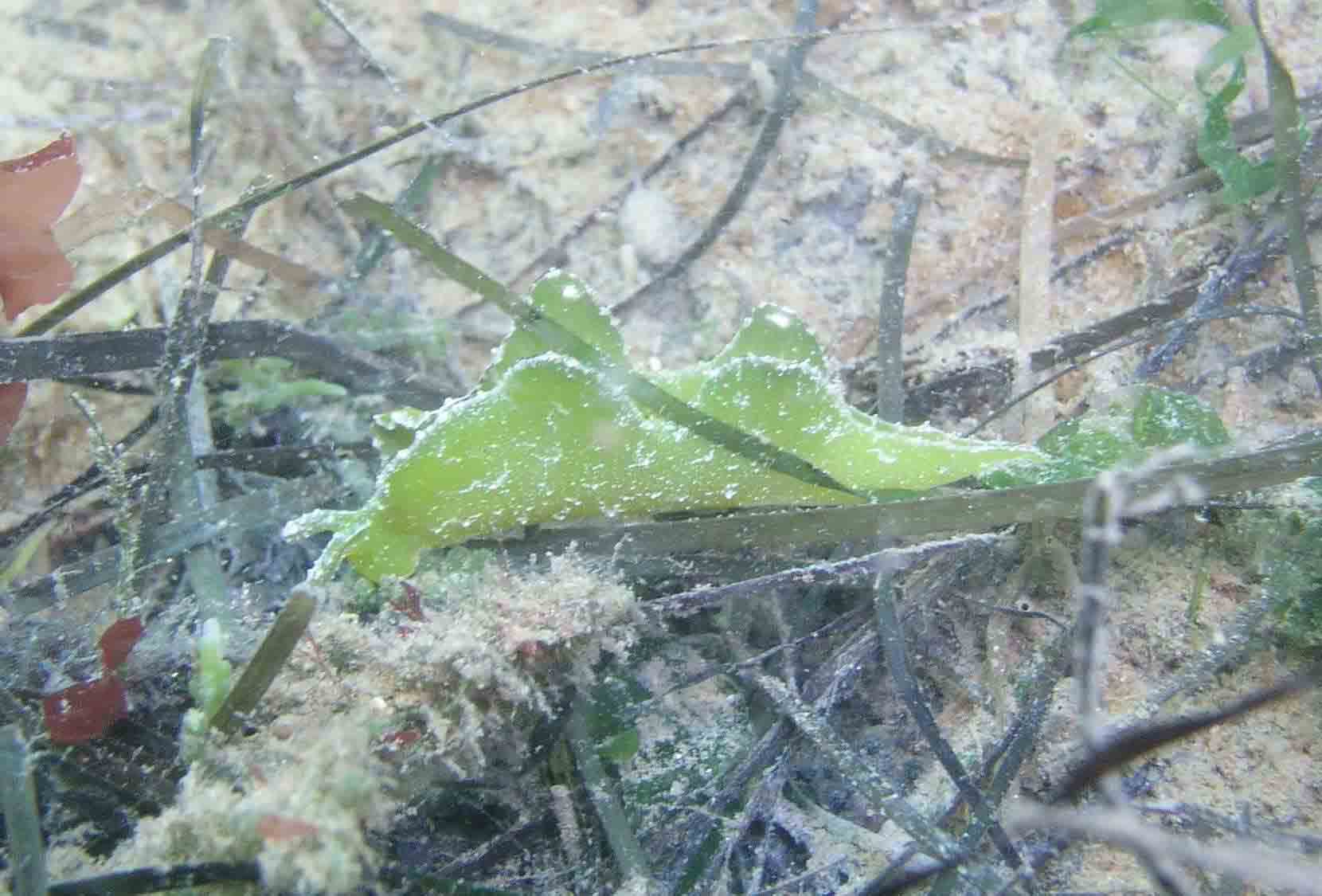
Elysia species
He contacted Nerida again, asking her to confirm this. I got involved
again and Nerida told me that it appeared what Dennis
had found was the same as what is illustrated as E. expansa in the WA nudibranch book. However, Elysia species are very difficult to identify, and
she also said that there is some doubt that the pictured animal in the book is
actually E. expansa. Nerida said that she has a friend in the United States who
is working on Elysia and she wanted to send a
copy of Dennis’s photo of the specimen to her friend and see if she wanted to
borrow the specimen. Nerida said “It’s really a bigger
problem to solve first (who is E. expansa?)
before we can say anything useful about what Dennis has
found. There are many cold-water animals that are shared between WA and SA, so
it may simply be an endemic temperate species.”
Philip Hall gave me a copy of Australasian
Nudibranch News 2:4 (Volume 2 (4):3 December 1999) which says that Elysia species belong to the family Elysiidae which “is the largest family of sacoglossans (sap sucking slugs). Elysiids have lost their shell & the foot is narrow and
the parapodia is large, leaf-like and wraps along the side of the body or
forms tall wings”. These details were in an article under the heading “Ophistobranch Feature” which discussed the species Elysia ornata in
detail.
(Australasian Nudibranch News is published
and distributed by Wayne Ellis. Check out http://www.ozemail.com.au/~glaskin
or contact the editor at glaskin@ozemail.com.au
.)
Flabellina species
Dennis has since reported finding two
species of Flabellina to the SA Museum,. His first sighting of a Flabellina was on the Dredge off of Glenelg. “It may
be "Spanish Dancer" in miniature” he said at the time. “I gave them (the SA
Museum) a photo of it”. Dennis then reported sightings of possibly another
species of Flabellina. This one was sighted on
the New Endeavour in the Port River. Flabellina are aeolid
nudibranchs of the family Flabellinidae. Many species
feed on a diet of hydroids. Aeolids are those
nudibranchs with cerata (groups of finger-like
processes) on their back.
According to “Australasian Nudibranch News
2:4 (Volume 2 (4): 3 December 1999) “The genus name “Flabellina” derives from the Latin “flabellum”
meaning “fan” and it defines a special gender of nudibranchs that share
certain physical characteristics, like having a dorsal fan of appendices called
cerata”. These details were in an article under the
heading “Mediterranean Nudibranchs” which discussed the species Flabellina affinis
in detail.
Dennis also found the following Flabellina species at Edithburgh jetty in
January 2005.
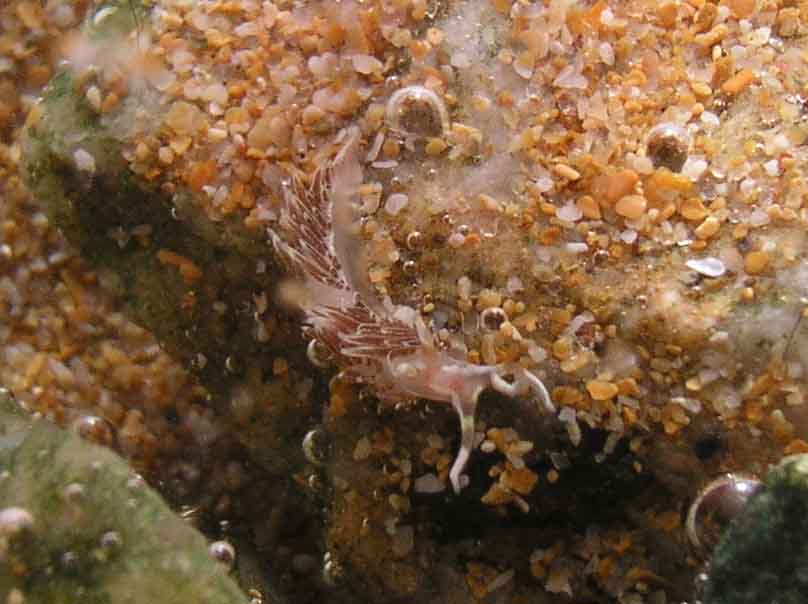
Flabellina species at Edithburgh
jetty
Aegires villosus
Dennis continues to make more nudibranch
discoveries. For example, on 23rd January 2005 he found a 10mm long
nudibranch at 6m under the Edithburgh jetty. He took a digital photo of the tiny
critter at the time.
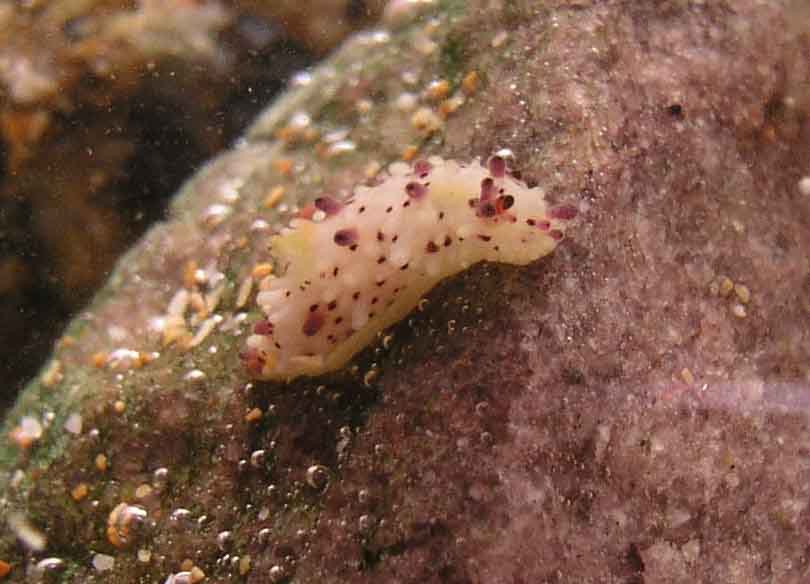
Aegires villosus under Edithburgh jetty
Back at home he started making enquiries
about what species the nudibranch was. As part of his enquiries he sent an email
message (with photo attachment) in to the Sea Slug Forum at http://www.seaslugforum.net/ . Dennis
soon received a reply from nudibranch expert Bill Rudman saying that the species was Aegires villosus.
According to the Sea Slug Forum’s fact
sheet for Aegires villosus, it is of the Suborder Doridina, Superfamily Anadoridoidea and Family Aegiretidae. It also says that the distribution of Aegires villosus is
widespread in the Indo-West Pacific.
According to the fact sheet, species of
Aegires are all small and they feed on
calcareous sponges. The purple tipped papillae make Aegires villosus
easily recognizable.
Bill Rudman had
found a 15mm long specimen of Aegires villosus at the Edithburgh jetty himself in February
1985. He told Dennis that they are one of a group of tropical species which is
also found in SA. He says that they probably travel here in the Leuwin Current. The current travels down
the West Australian coast and sends a branch east along the south
coast.
Dennis’s photo of his Aegires villosus
specimen was posted on the Sea Slug Forum. At 10mm in length, it would be either
an adult or sub-adult. There are two photos of Aegires villosus on
the fact sheet (both by Bill Rudman).
The first photo features Bill Rudman’s specimen from Edithburgh. The second one features a
3mm specimen found at New Caledonia in October 1993. Both specimens look quite
different to the one in Dennis’s photo. They are more elongated and also have
longer papillae.
Bill Rudman told
Dennis that SA specimens seem to be fatter than their more spectacular siblings.
The fact sheet says that the papillae of juveniles are much longer than those of
the adults and this was confirmed by Bill who told Dennis that the fatter SA
specimens also have smaller papillae.
Aegires villosus was first described by GP Farran in 1905 from specimens collected at Ceylon (now Sri
Lanka) by Professor Herdman in
1902.
Dennis continues to liaise with Thierry
and Nerida at the SA Museum. He has been informing
them of things such as the appearance or disappearance of the different species
of nudibranchs. The Polycera hedgpethi season for this year has now ended whereas the
Elysia species are still quite abundant at
present in October.
One thing that Dennis wishes to stress is
that there is every chance that his sightings were not necessarily the first to
occur in SA but he was one of the first to report his sightings to the SA
Museum. The main thing is that Dennis has passed important information on to the
Museum. He encourages others to follow his lead in these
matters.
Dennis placed some nudibranch specimens in
his home aquarium and has been able to make some interesting observations such
as what they will eat, what will eat them and what won’t eat
them.
Philip Hall also gave me a copy of “The
Sea Slug Forum – Species List” in 2000. This list gives the following details:
-
Order Sacoglossa
Order Nudibranchia
Superfamily Elysioidea
Suborder Doridina
Family Elysiidae
Family Polyceridae
Elysia species
Subfamily Polycerinae
Polycera hedgpethi
Order Nudibranchia
Order Nudibranchia
Suborder Aeolidina
Suborder Doridina
Family Flabellinidae
Family Aegiretidae
Flabellina
species
Aegires villosus
My thanks to Dennis
Hutson, Philip Hall, Nerida Wilson and Thierry Laperouzas for their considerable assistance with the above
details.
Photographic credits go to Dennis Hutson
for all pictures except for the picture of the New Endeavour which goes to
Noeleen Reynolds.
REFERENCES:
Australasian Nudibranch News 2:4 (Volume 2
(4):3, December 1999)
The Sea Slug Forum – Species
List
“Nudibranchs of the South Pacific Vol.1”
by Neville Coleman
“Rare Nudibranch Discovery” by Steve Reynolds,
MLSSA Newsletter No.316, November 2004, published by the Marine Life Society of
South Australia.
by
Chris Hall
The
Apple Isle or Tasmania, so called the for the high quality apples grown there is
also a world class dive site.
Tasmania
is an island haven at the edge of the world where you can travel through
pristine world heritage listed wilderness. You can observe the unique wildlife
such as the Tasmanian Devil and Tasmanian Tiger,
although thought to be extinct but not by some locals, found nowhere else in the
world. As well as this unique fauna Tasmania offers a unique and diverse marine
life.
I have
visited Tasmania a few times over the years, the last being in 2000 and I was
hoping to get to dive then but time restrictions didn’t allow. When I heard of a
trip being planned for Easter 2005 I immediately put my name down for the
ensuing trip and waited patiently for Easter to arrive.
Easter
Thursday morning and about twenty of us arrived at Adelaide airport for the
direct flight to Hobart.
On
arriving at Hobart, having collected our baggage and dive gear we were met by
some of the staff of the Eaglehawk Dive Centre. We loaded our gear into the
various vehicles and were introduced to our driver, who someone commented,
looked like a pirate with his craggy face and a bandana wrapped around his head.
His name was Pete.
The trip
to Eaglehawk Neck is about 80 km and takes just over an hour however we had to
stop at Sorell to get some shopping as the accommodation was bunk style and self
catering. Pete suggested we stop at an oyster farm not far out of Hobart and get
some fresh oysters; he didn’t meet with any resistance so after shopping in
Sorrell we sat in the mini-bus and ate our fresh oysters.
On
arriving at the dive centre we unpacked our gear, selected our bunk beds and
organised the food and drink. The accommodation was comfortable with kitchens
and lounge areas as well as toilets and showers off the bedrooms.
Having
checked out the living accommodation we went down to sort out our dive gear in
the main part of the dive centre and find out what group we in for the three
days of diving as well as being introduced to our hosts Gary, Mick and Karen.
Mick’s mother comes from Donegal so over the weekend I was quizzed about diving
in Donegal.
Once all
the intros were done I decided to have a scout around, see the lie of the land
and take a few photos of our accommodation and dive centre. Just as I got the
camera out it started to drizzle then rain, I thought I was back in
Ireland.
Our first evening
in Eaglehawk and we decided to eat at the local hotel, the only one, as we had
an early start the next day. As there were eighteen divers and the boat only
took six divers we had to divide into three groups which meant if we were all to
get two dives a day the first group needed to be kitted up by 7am. So after an
enjoyable meal we headed back to the dive centre and four days of magical
diving.
After a
quick breakfast of cereal and fruit juice it was time to kit up and head for the
harbour. It had rained all night but fortunately it had petered out and the day
dawned overcast but dry. The trip from the dive centre to the harbour at Dotown
is about five kilometres and undertaken in an old Toyota four wheel drive,
affectionately known as ‘the troop carrier’, and very temperamental when trying
to start.
Once the
boat was launched and the gear stowed we were on our way and our diving
adventure started.
The
topography as we headed out the dive site is amazing, sheer cliffs jut straight
up from the ocean floor and in some places reaching 300 metres with small bays
giving shelter from 3-4 metres swells coming up from the Antarctic. Mick
selected one of these bays called Waterfall Bay which was aptly named as a small
waterfall cascaded down the cliffs not far from where we were diving. I was
buddied with Pete (not Pete the Pirate), who fortunately had been lucky enough
to have dived here before, and given a quick dive brief.
On
entering the water it lived up to everything we’d been told, cold 14-16 deg C.
The cliff face dropped down to 15- 20 metres strewn with boulders. The
visibility was 15 metres plus and there was some surge when close to the cliffs.
The marine life is
just spectacular. Rising up from the sea floor 6-10 metres is brown algae (kelp)
and swimming through kelp is a myriad of different fish. Bastard trumpeters,
blue throated wrasse, black spotted wrasse, banded morwongs, toadfish, a huge
stingray and two weedy seadragons (female). The seadragons were the highlight of
this dive as they were both very colourful and are just an amazing fish. If
nothing else we are very lucky living and diving in southern Australia where the
only two species of seadragon inhabit our coastline. The invertebrate marine
life is nearly as spectacular with giant cuttlefish, crayfish and all sorts of
encrusting growth covering the rocks, including sponges, ascidians, anemones,
zoanthids, bryozoans, sea and feather stars as well as all sorts of red, green
and brown algae (seaweed). Fifty minutes dive time seemed like five as we were
so engrossed in our surroundings, we reluctantly surfaced as our air supply
dwindled. With dive one completed and six to go we headed back to base to have
something to eat and await our next aquatic adventure. We weren’t to be
disappointed.
To be
continued
ANNIVERSARY TROPHY
RE-VAMP
by Steve Reynolds
When our Anniversary Trophy was first
presented, it was thought that the holder could then decide who the new
recipient would be the following year. Our committee now realizes that this
concept leaves much to be desired. We have decided that the committee itself
will make the decision about who to present the trophy to each year. Many issues
will be considered when the decisions are made. It is even possible that, at
times, the trophy will not be presented to anyone at all. Make sure that you are
present at the June Meeting to either witness the presentation or to receive the
trophy yourself. It will then be our 29th anniversary and worthy of a
celebration.
YEAR
ANNIVERSARY
RECIPIENT
2001
25th
Philip Hall
2002
26th
Margaret Hall
2003
27th
Phill McPeake
2004
28th
Danny Gibbins
2005 29th
??